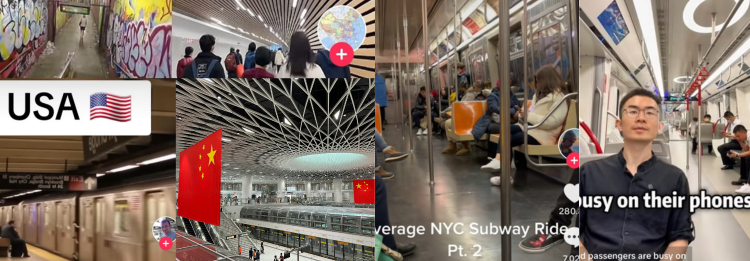One can simply type in China vs US subway on the internet and find multiple social media platforms, like Tiktok and YouTube, showing videos that contrasts China’s advanced metro systems with the aging New York Subway, emphasizing China’s rapid development and technological superiority in urban transit.
Modern Infrastructure
China’s metro systems in cities like Shanghai, Beijing, and Shenzhen exemplify modern infrastructure. Shanghai Metro, one of the largest globally, boasts over 700 kilometers of track and employs cutting-edge technologies such as automated trains and comprehensive surveillance systems. Stations are well-maintained, clean, and equipped with modern amenities, including air-conditioned platforms. Expansion projects are frequent, with new lines and extensions being completed swiftly to ensure even the most remote areas are well-connected.
Aging Infrastructure
In stark contrast, the New York Subway, though historic and iconic, struggles with aging infrastructure. Many parts of the system are over a century old, leading to frequent breakdowns and maintenance issues. Technologically, the subway lags behind, with automated trains and modern signaling systems only recently being introduced. Cleanliness and safety concerns are prevalent, and stations often face criticism for being grimy and overcrowded. Expansion projects, like the Second Avenue Subway, take decades to complete and are costly.
Efficient Systems
Efficiency is a key difference between the two systems. Chinese metros are known for their punctuality and reliability, thanks to automated systems and regular maintenance. The New York Subway, however, faces frequent delays and service interruptions. The passenger experience in China’s metro systems is enhanced by modern trains, well-maintained stations, and amenities such as Wi-Fi and mobile charging stations. In New York, the experience is often marred by outdated facilities and limited amenities.
China continues to invest heavily in expanding and upgrading its metro systems. Cities like Chengdu and Guangzhou are constructing extensive new lines with the latest technologies to improve efficiency and passenger experience. In contrast, while significant investments are being made to modernize the New York Subway, progress is slow and often hindered by bureaucratic and financial challenges.
Several factors contribute to China’s success in infrastructure development. Strong government support and funding enable rapid development and implementation of large-scale projects. Centralized planning ensures coordinated efforts across various cities, maintaining uniform standards and efficient resource allocation. Additionally, heavy investment in research and development facilitates the adoption of cutting-edge technologies in transportation infrastructure.
Contrast
China’s ability to execute large infrastructure projects efficiently and incorporate advanced technologies stands in stark contrast to the slower, more bureaucratic processes in the U.S., highlighting significant differences in their approaches to urban transit development.
Credits: Tiktok Videos @jasonlivinginchina, @sarahfunkyy
Watch Tiktok videos here:
@jasonlivinginchina The US is Far Behind China…(Americans Shocked) chinavsusa livinginchina chinavsusa usavschina chinametro usa china metro subway newyork newyorksubway
@sarahfunkyy Here is why our subway is THE BEST 😂 #mta #subway #nyc #comedy
More from Wakeup Singapore:
Influencer Esha’s Death Leads to Arrests in Cyberbullying Incident
Indulging in a Kaya Toast Set at the Intercontinental Hotel Worth the Splurge?
If you have a story or a tip-off, email admin@wakeup.sg or get in touch via Whatsapp at 8882 5913.
Since you have made it to the end of the article, follow Wake Up Singapore on Telegram!
Wake Up Singapore is a volunteer-run site that covers alternative views in Singapore. If you want to volunteer with us, sign up here!
If you can, please do consider buying a mug or two to support Wake Up Singapore’s work!







